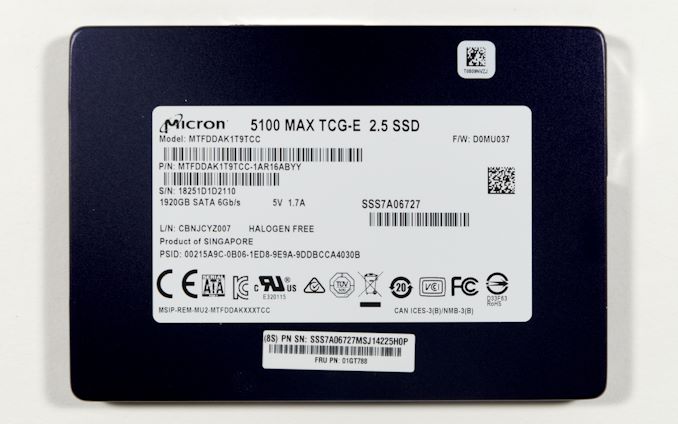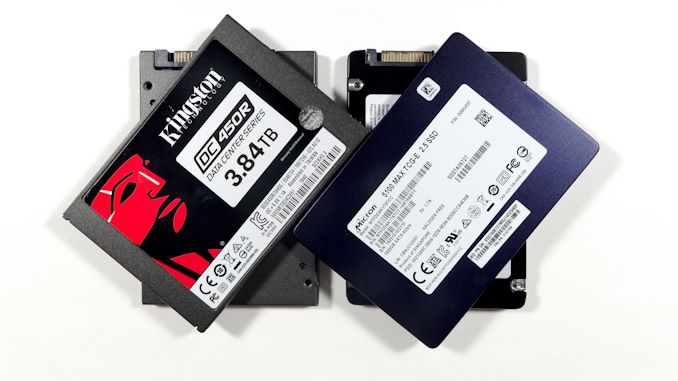Enterprise SATA SSDs: Can Budget 2020 beat Top Line 2017?
by Billy Tallis on February 4, 2020 11:00 AM ESTConclusion
Kingston's new DC450R rounds out their stack of enterprise SATA SSDs with a more budget-oriented entry level model. It's meant for heavily read-oriented workloads and handles them well, but it also offers good peak write performance that holds up for quite a while before dropping down to steady state. The big caveat is that it does not include power loss protection, a feature that's usually standard on enterprise SSDs. There's a growing number of entry-level drives that target this niche, but buyers do need to beware and ensure their intended use case does not require PLP.
The DC450R inherits a lot of characteristics from their existing DC500 series, since they share the same Phison S12DC controller. These drives have no trouble saturating the SATA link and offering decent QoS for the intended workloads, but Samsung's competitors consistently have better power efficiency and usually also superior QoS.
The Micron 5100 MAX is a relic of days gone by; few vendors make SATA SSDs like this any more, and when they do they are expensive niche products. The 5100 uses older, slower 3D TLC NAND and that holds it back in a few performance tests—especially latency metrics. But the excessive overprovisioning of this MAX variant allows it to overcome the handicap of slower NAND and deliver throughput that matches the best of today's enterprise SATA drives. The 5100 MAX also owes much of its staying power to the fact that the SATA bottleneck has not moved at all, and by 2017 even some TLC drives could hit that limit on a sustained write workload. Without that performance ceiling, there's little reason to expect 2-3TB of current-generation 3D TLC to perform the same as such an old drive.
The power efficiency of the 5100 MAX is also surprisingly competitive. Micron's first-generation 3D NAND was slow but didn't require too much power, and the controller used by the 5100 was also popular for consumer SSDs destined for battery-powered systems. Since that combination is still able to compete on performance against much newer drives, the low power consumption leads to decent power efficiency—though not as good as the Samsung drives.
Just about any enterprise NVMe SSD will blow all these SATA drives away when it comes to performance on more read-oriented workloads. For more write-heavy workloads, the NAND flash is more often the bottleneck and NVMe drives have a much smaller advantage, or none at all for lower-capacity and low-endurance models. This is where the Micron 5100 MAX really still shines; entry-level enterprise NVMe SSDs usually don't have enough overprovisioning to sustain the random write speeds the 5100 MAX provides.
| 480 GB | 960 GB | 1.92 TB | 3.84 TB | |
| Kingston DC450R | $150.21 (16¢/GB) |
$275.42 (14¢/GB) |
$518.09 (13¢/GB) |
|
| Kingston DC500R | $105.80 (22¢/GB) |
$166.31 (17¢/GB) |
$317.52 (17¢/GB) |
$601.80 (16¢/GB) |
| Kingston DC500M | $118.57 (25¢/GB) |
$218.38 (23¢/GB) |
$407.41 (21¢/GB) |
$749.01 (20¢/GB) |
| Micron 5100 MAX | $299.99 (16¢/GB) |
|||
| Samsung 860 DCT | $182.44 (19¢/GB) |
$331.04 (17¢/GB) |
$687.75 (18¢/GB) |
|
| Samsung 883 DCT | $119.99 (25¢/GB) |
$206.39 (21¢/GB) |
$365.95 (19¢/GB) |
$650.99 (17¢/GB) |
Judging the affordability of server SSDs is always difficult because retail sales are never the primary distribution channel. When a drive can be bought on Amazon or Newegg, it's usually through a third-party seller. Capacity selection and stock is often limited, as is the case with the Micron 5100 MAX being sold by MyDigitalDiscount. The prices we see can be very different from what bulk purchasers see. But right now, Kingston and Samsung have product lines that include retail distribution as part of the official business model, and we can make reasonable comparisons about relative prices even if we cannot directly analyze the bulk pricing that large business customers pay.
The Kingston DC450R seems to slot in nicely below the DC500R, which already undercuts the largely inferior Samsung 860 DCT. But at lower capacities, the DC450R either has limited availability or isn't much cheaper than the DC500R. Overall, Kingston's three models seem well-positioned to compete with Samsung's SATA options.
While supplies last, the 1.92 TB Micron 5100 MAX from MyDigitalDiscount is pretty good deal, currently about 18% cheaper than the Samsung 883 DCT. For read-heavy workloads it's only a little bit slower than the Samsung, and for very write-heavy workloads it can't be beat by any current SATA drive.













20 Comments
View All Comments
FunBunny2 - Wednesday, February 5, 2020 - link
"So, even a "serious" database running on any reliable disk (ie: one not lying about flushes) will be 100% functional/safe; however, performance will tank."industrial strength RDBMS still offer (on *nix OSs, at least) raw devices, which means the database engine does all the I/O, and always (IIRC) runs with more integrity guarantees and efficiency. it's just that *nix OSs have gotten sufficiently better at both over the last couple of decades that most RDMBS app developers discourage their clients from configuring that way.
FunBunny2 - Wednesday, February 5, 2020 - link
"There is a difference between data integrity and persistency, but power-loss protection is needed for either."depends on what the definition of 'it' is. way back in the late 80s and early 90s, SQL databases ran on machines without UPS or other forms power persistence. what industrial strength RDBMS did guarantee is that a use session would lose only its last in-memory transaction. app developers took this into account when designing transactions. they still have to, since any number of failure modes exist beyond just pulling the plug. RDBMS did, and still do, only guarantee integrity of data written to the write-ahead-log, which is where in-memory data is flushed on transaction completion. widespread use of storage class memory, and OS support for same beyond simulating a filesystems (gad!), will change this protocol. won't be next week.
Siddhartha - Wednesday, February 5, 2020 - link
Is there something I can do to stop your endless loop video popups? I understand you earn your living with advertising but the popups actually block your content. I usually spend a couple minutes on website and go somewhere because of the popups.RealBeast - Wednesday, February 5, 2020 - link
What video popups? cough, MVPS host file blocking, coughleexgx - Wednesday, February 5, 2020 - link
I exclusively use edge mobile browser on this website (the forums are even worse a floating video that follows you when you move up and down blocking over 70% of the page) 3 other sites that I use it on as well as they launch full screen ad when you click on a link for the first time or i page ads are floating with the page or randomly opening other pages when you try to swipe down (it thinks your tapping the add when your trying to pull down)Supercell99 - Wednesday, February 5, 2020 - link
Nothing about the Kingston drives are "Enterprise" . The DWPD are nothing special. The lack of power loss protection capacitors is a deal breaker. I don't care if it is read heavy. Enterprise means, critical data and business use with $$$$ at stake. Loss of data and downtime is very expense. No power caps and <1 DWPD makes this just another SATA SSD, "Enterprise" is some label they threw on to make some extra cash from suckers.Foeketijn - Saturday, February 8, 2020 - link
I bought a samsung 983 for 200 something euro's.Nice to install Windows server in about 2 minutes (and then need about 10 to go thought the bloatware options).
dromoxen - Wednesday, February 12, 2020 - link
Its a shame they couldnt do a quick re-write of the firmware , nobody? needs 42% over provisioning. Maybe take it down to 5,10.. that can be changed on installation. Voila , a shedload of extra capacity, which I would presume is the second selling point , after simply being a SATA ssd.